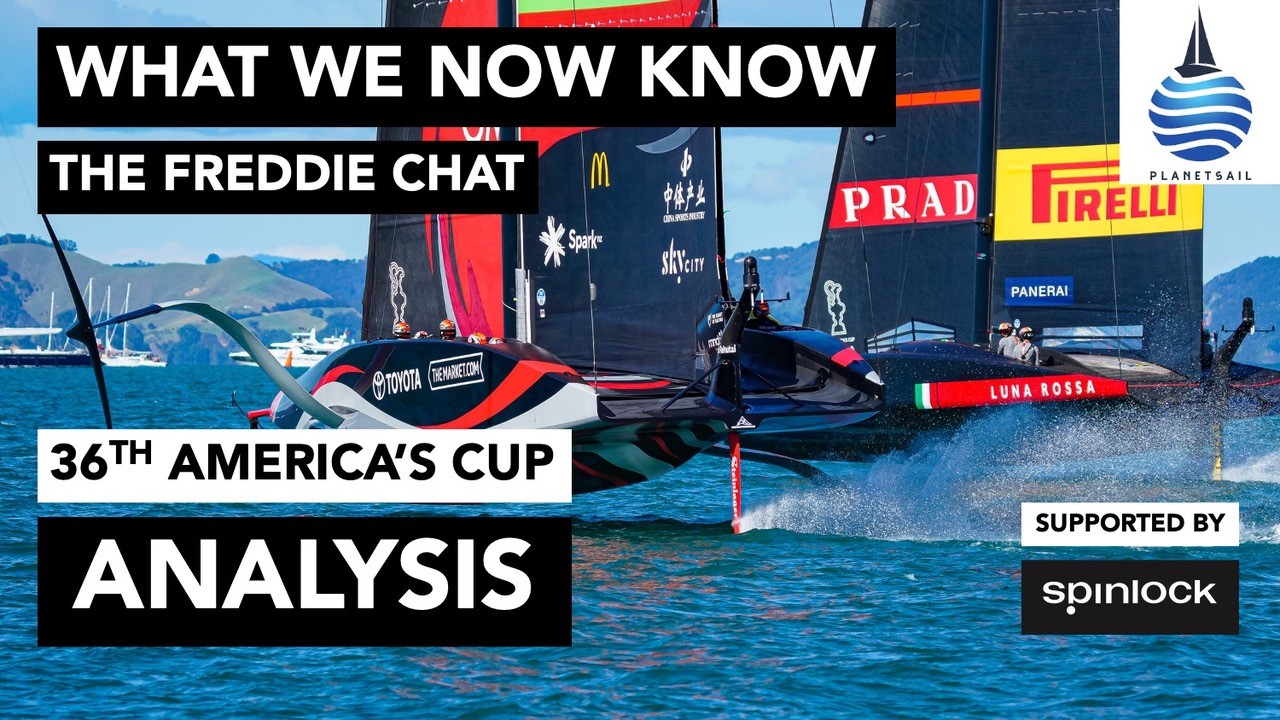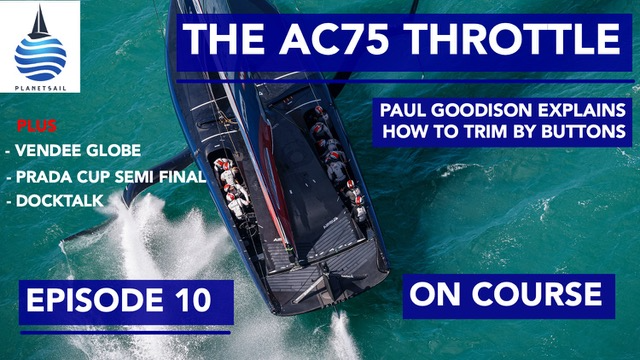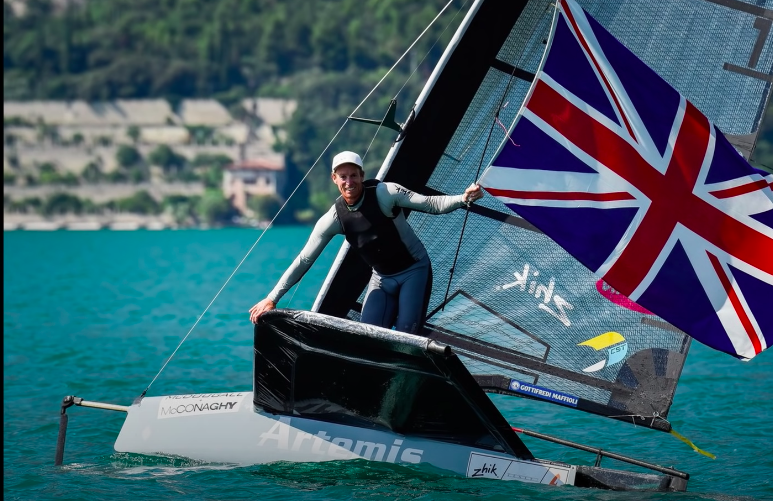Alan Smith is one of the smartest observers of all things foiling, having been approached back in 1999 to design a full set of foils for David Lugg’s International 14. Since 2008 the Australian has worked with Kevin Ellway on developing the world-beating Exocet design of International Moth. He also contributed to design work for Will Sunnucks’ foiling 20ft catamaran, the Vampire.
With a strong background in aircraft stability control and the flight dynamics of missiles, including a five-year stint as chief engineer for British Aerospace Australia, Alan is well placed to comment on the aero/hydro dynamics of a foiling AC75. He doesn’t like everything he sees...
On numerous occasions AC75s have been seen to heel and pitch upwards very suddenly. It usually ends in the boat crashing down and on occasions the boat capsizing. Of these incidences the American Magic capsize being the worst (so far). On Facebook (https://www.facebook.com/groups/2397006860595933) William Sunnucks wrote about his experience with Vampire, his 20-foot foiling cat. About 5 or 6 years ago William carried out some experiments that directly relate to the unwanted gyrations that are occurring with the 75s. The motion is a combination of pitch and heel (roll) is known as ‘Dutch roll’ in aircraft lingo.
Vampire, being a cat, has two rudders and rudder foils and two retractable forward foils, windward one retracted, leeward one down. The deployed foil canted at 20 degrees. Like the AC75 configuration but with two rudders. At times, when Vampire was sailed with both rudders in, what William called wheelies and now uses the term “flouts” (fly outs) occurred . He carried these experiments with only one rudder /foil deployed. What he found was with the lee rudder down the flouting problem was not evident.

With the windward rudder down and the lee up the boat was near unmanageable continuously trying to flout. The axis of lee foil to windward rudder relative to centre line of Vampire is a little greater than the same angle for 75s. In my opinion this conclusively demonstrates that there is an inherent instability in the 75’s configuration and it would also be present in any foiling yachts of the same layout.
Vampires flaps are wand controlled (as per the International Moths) and as a consequence the flouts are not in any way caused by in appropriate flight controller actions or incorrect control algorithms when experienced by 75’s. In American Magic’s case unwarranted additional flap was probably applied causing the massive lift out and subsequent damage. A more appropriate action would be to put the flap full trailing edge up, keeping the boat close to or on the water and hence avoiding serious damage. There was no way of avoiding the capsize after the flout was initiated (about 7 seconds before complete capsize) other than letting all the pressure out of the main and steering the boat under the mast.
It is important to understand that stability of motion (aircraft, missile, car or boat) has nothing to do with the forcing functions of the operating environment. The forcing functions can overpower but not destabilize a dynamic system. If an instability is inherent then the forcing function is amplified by the instability and the outcome can be very serious. A simple tuning fork is a good example of how very low damping results in sustained motion aft minimum disturbance.
I am confident that flouts can be initiated by high turning rates as a result of yaw to pitch dynamic coupling. The AC75 lateral cross product of inertia when one foil is raised and the other down creates this coupling.
Here’s an analogy:
Consider two cars, both at the same speed driving a straight but steeply banked road. One high on the bank and one low, linked together by a fixed rod. The bank is high on the right side but while the road is straight the link between them is not a problem. Now the road goes into a constant radius left turn maintaining the same angle of bank. Looking at the cars from the centre of the radius the lower car should will have a greater rate of turn if unlinked, because of the link the lower car is pulled up the track and the upper one down. In elevation this is a pitch rate caused by the turn rate and it has occurred as a result of the acceleration in yaw at the increment in time when the track commenced to turn. If you wish you can put a large truck midpoint of the link. It’s yaw and pitch inertia just slows the subsequent yaw and pitch accelerations down but does not change the resulting pitch rate.
The problem is readily overcome for the AC75’s by bearing away with both foils down when circumstances mean bearing away with one up are dangerous. They are already staying on two foils when rounding up at the lee mark as they have found it helps to stay up foiling. Rounding up causes a bow down pitch for the same reason bearing away causes a bow-up pitch.
The American Magic capsize
Frame by frame analysis indicates the crew had less than 2 seconds to let the main run and stop the capsizing from occurring. Speed was a contributor as it provided the kinetic energy that sent the boat skyward. It also seriously reduced decision-making time for a crew that clearly did not have their decision-making process sorted. The back stay contributed but was not the root cause. Even with the backstay released it would have been necessary let the sheet run to have avoided the crash by the time the sail was against the back stay. Once the boat commenced to heel the rudder to foil skew compounded the problem by increasing angle of attack of both foils. However, I believe that the initial bow-up motion was caused by yaw to pitch coupling cause by the large cross product of lateral inertia that exists one foil up and one foil down.
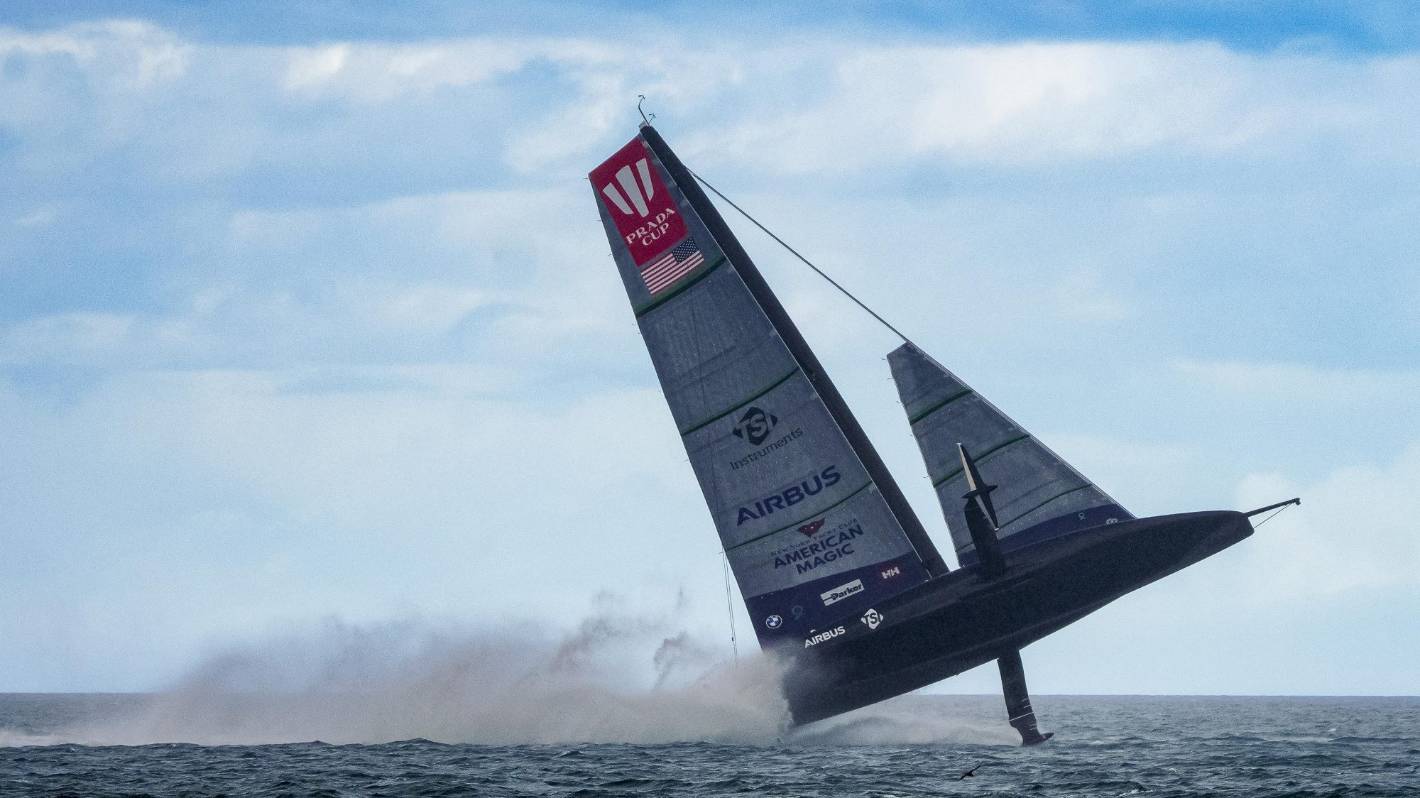
The INEOS mini-flout in pre-start of Race, Prada Cup Final
The INEOS crash pre-race 4 was almost certainly initiated by the windward foil being used to pulling down to balance and slow the boat. Lifting it out without first easing the main and setting the flap to zero lift resulted in the boat pitching bow up and an over sheeting position of the main to set in motion a similar lift out as the Americans and Kiwis have suffered.
With both foils down the flight controller can control both pitch and heel but once on one foil only, the flight controller must never try to correct heel angle. Heel angle becomes the sole responsibility of the sail trimmer. The helmsman turning the boat quickly without sail trimmer coordination risks a flyout.
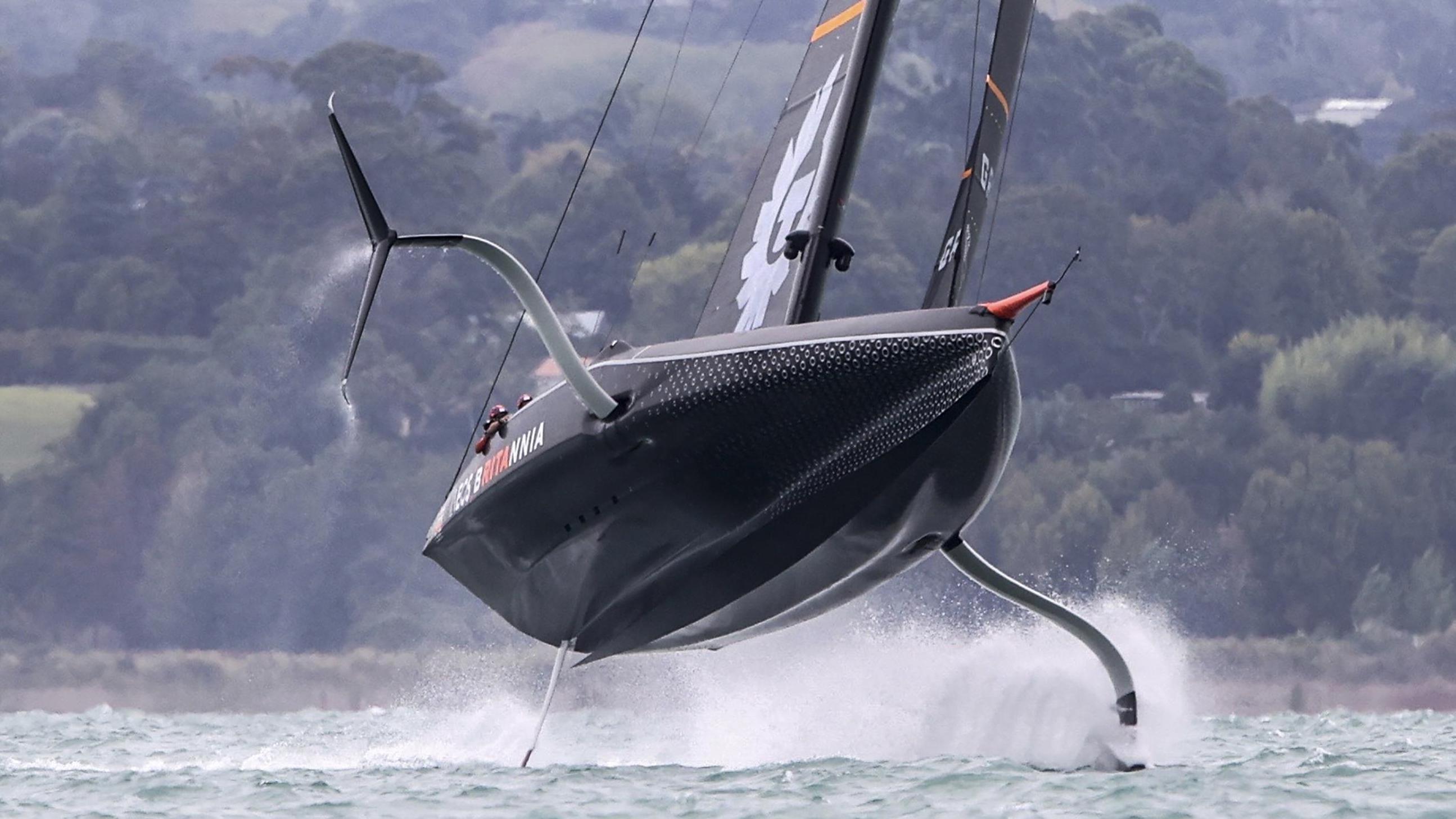
Here are two cases of a nominal simulation of Ineos's flout:
Case 1
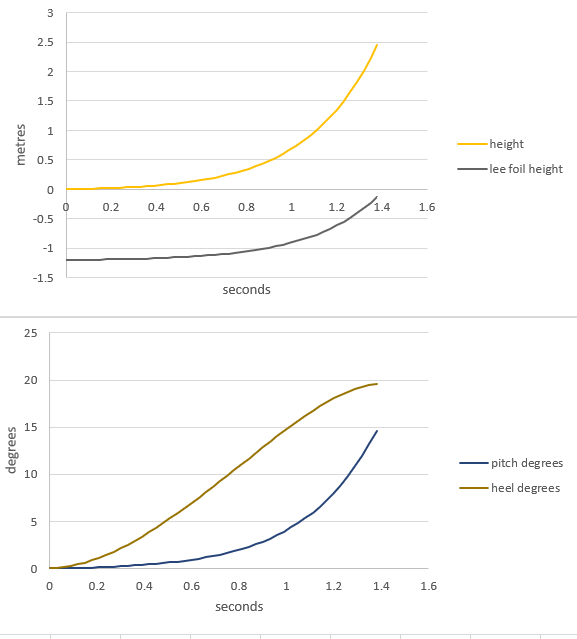
Case 2
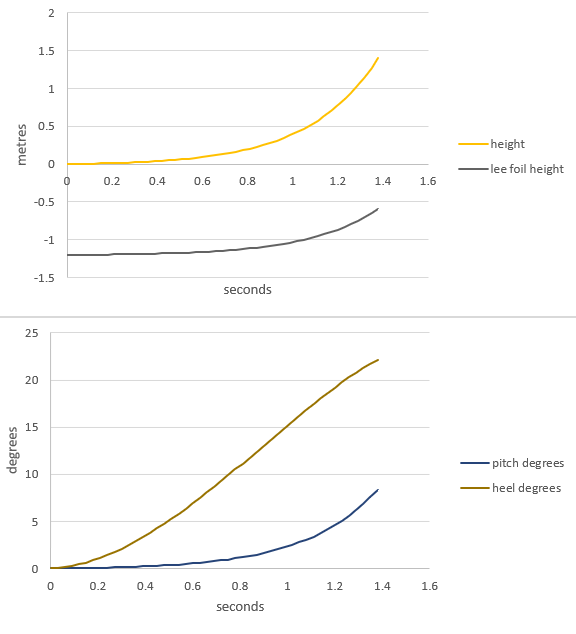
The first starts with the windward arm pulling down with 7000 newtons (~700kg) and the second with 4000 newtons pull down. The simulation is based the assumption that the boat is travelling in a straight line at constant speed and heeling moments are balanced. The only crew action taken into account is that the windward foil is raised with a down-load until it clears the water. The time base of the simulation commences as the foil clears the water. In actual fact it may have been raised with the load on or its flap angle being set slightly trailing-edge down to aid lifting the foil. Either action would initiate the flout.
WHY ALAN ISN'T A FAN OF THE AC75 CONFIGURATION
Any action that initiates a heel angle will result in flouting - be it cross product of inertia lifting the bow in a turn, hence the height of the boat, putting the helm down in a gust or as in Ineos's case - raising the windward arm while loaded. If any force pushes the boat up at its centre of gravity, the lee foil will refuse to rise quickly because of the water forces on it and as a consequence the boat heels over.
I would like it to encourage design teams of future foilers to avoid - or possibly be prohibited on safety grounds - setting up a rudder to forward foil heeling axis which is more than 2 or 3 degree skew to the longitudinal axis; secondly to limit the ratio of lateral cross product of inertia to pitch inertia of the boat to not greater than, say, 0.10. Specifically do not use a foil deployment / extraction configuration where the foil mass is a very high proportion of all-up weight.

